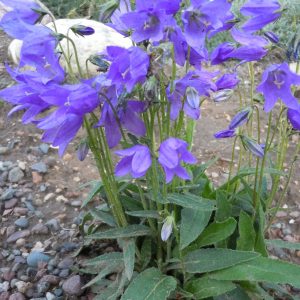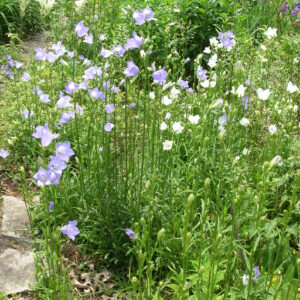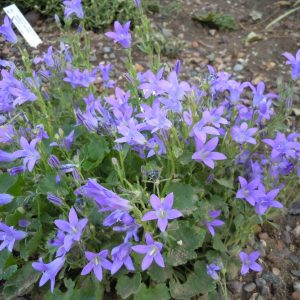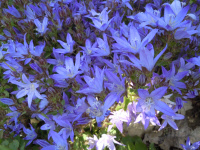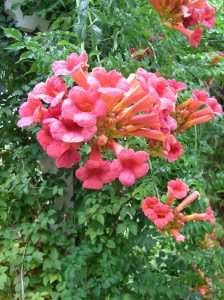Shop
Showing 145–152 of 788 results
-
Campanula collina Dark blue bellflower Z. 5-8
In summer dark blue-purple bells on upright stems on clumps of this bellflower.
ARCHIVED
Note: This is a plant not currently for sale. This is an archive page preserved for informational use.
In summer dark blue-purple bells on upright stems on clumps of this bellflower.
Size: 6-12” x 8”
Care: sun to part shade in well-drained to moist well-drained
Native: western Asia, Turkey, Caucasus MountainsCampanula is Latin meaning “little bell.” Collina means “on hills.” Collected before 1826.
-
Campanula ochroleuca Bellflower Z 4-7
Ivory, rocket-shaped buds open to bell-like blossoms covered with fine hairs with five, flared petal-ends surrounding ivory stamens and pistil along erect to arching stems. Blooms June-July on slow-spreading, clump-forming rosettes of hairy, heart-shaped or triangular leaves.
ARCHIVED
Note: This is a plant not currently for sale. This is an archive page preserved for informational use.
Ivory, rocket-shaped buds open to bell-like blossoms covered with fine hairs with five, flared petal-ends surrounding ivory stamens and pistil along erect to arching stems. Blooms June-July on slow-spreading, clump-forming rosettes of hairy, heart-shaped or triangular leaves.
Size: 12-18” x 12-15”
Care: sun to part shade in moist well-drained to well-drained soil
Native: Caucasus
Wildlife Value: provides pollen to bees and butterflies, rabbit resistantFirst described in a published document in 1949.
-
Campanula persicifolia Peach-leafed bellflower Z 3-8
June – July (with deadheading) white or blue open-facing bell flowers along the top foot of the erect, leafless stems.
June – July (with deadheading) white or blue open-facing bell flowers along the top foot of the erect, leafless stems.
Size: 24-36" x 10"
Care: Sun in moist well-drained soil.
Native: EuropeCampanula is Latin meaning little bell. Persicifolia means leaves like a peach. Both white and blue ones of C. persicifolia grew in English gardens before 1580, then described in literature by Scottish botanist Robert Morison (1620-1683). English herbalists prescribed C. persicifolia for ailments of the mouth and throat and to clear complexions.
-
Campanula portenschlagiana Dalmatian bellflower Z 4-8
Purple, upfacing bells for months in mid to late summer
Purple, upfacing bells for months in mid to late summer
Size: 4-6” x 20”
Care: full sun-part shade in moist well-drained soil
Native: Northern Yugoslavia
Awards: England’s Royal Horticultural Society Award of Merit. Top rated Chicago Botanic Garden & Elisabeth Carey Miller Botanical Garden Great Plant Pick.Campanula is Latin meaning “little bell.” 1st described in Systema Vegetabilium 5: 93 in 1819 by one of its discoverers, Franz Edler von Portenschlag-Ledermayer (1772-1822).
-
Campanula poscharskyana Adriatic bellflower, Serbian bellflower Z 4-8
Riot of lilac colored star-shaped blooms May – June over this short, trailing mound of leaves.
Riot of lilac colored star-shaped blooms May – June over this short, trailing mound of leaves.
Size: 6" X 24" spreads
Care: Sun to part shade in moist well-drained soil.
Native: Mountains of Eastern Europe
Awards: Top rated by the Chicago Botanic Garden. Elisabeth Carey Miller Botanical Garden Great Plant PickCampanula is Latin meaning “little bell.” Collected before 1822. Named for 19th century German plantsman, Gustav Poscharsky.
-
Campanula punctata var. rubriflora Z 4-9
Dangling rosy purple bells hide their red spots inside the petals
ARCHIVED
Note: This is a plant not currently for sale. This is an archive page preserved for informational use.
Dangling rosy purple bells hide their red spots inside the petals – early summer
Size: 12”x16” & spreading
Care: Sun to part shade in moist well-drained soil
Native: Japan
Awards: Top rated for ornamental traits and landscape performance by the Chicago Botanic Garden.Campanula is Latin meaning little bell. Punctata means spotted. In 1629 Parkinson described campanulas as “cherished for the beautie of their flowers.” This variety collected in Japan before 1950.
-
Campanula rotundifolia Harebell, Bluebell of Scotland Z 3-8
Its delicate appearance conceals its hardy constitution. Dainty bluish-lilac bells to 12” stems on bushy round ground-hugging foliage. Blooms from June to October and occasionally November. Perfect for rock gardens and borders.
OUT OF STOCK
Its delicate appearance conceals its hardy constitution. Dainty bluish-lilac bells to 12” stems on bushy round ground-hugging foliage. Blooms from June to October and occasionally November. Perfect for rock gardens and borders.
Size: 9-12" x 12"
Care: Sun to part shade in moist well-drained soil
Native: Europe, Siberia and North America, including Wisconsin
Wildlife Value: Walnut and deer tolerantLakota ate the leaves raw and cooked and made an infusion of the roots to remedy earaches. Sir Walter Scott immortalized the Bluebell of Scotland in Lady of the Lake. Also a subject of Emily Dickinson’s poetry.
-
Campsis radicans Trumpet vine Z 5-9 VINE
Huge, gorgeous orange trumpets on vigorous vine
Mid-summer to early autumn – huge, gorgeous orange trumpets on vigorous vine
Size: 30’ x 3’ at base
Care: sun, moist well-drained soil. Prune in late winter or early spring by cutting back side shoots to within 2-3 buds of main stem
Native: PA to IL & south as far as Florida
Wildlife Value: magnet for hummingbirds, long-tongued bees, and Sphinx moths.In garden cultivation in America since early 1600’s. Collected in 1640’s by Tradescant the Younger (1608 – 1662), son of John Tradescant the elder. He went in person to Virginia between 1628-1637 (and possibly two more trips by 1662 to collect plants. When his father died, he succeeded as head gardener to King Charles I and Henrietta Maria from 1638 to 1642, when the queen fled England’s Civil War. Campsis is derived from the Greek word kampsis referring to the flower’s curved stamens. Radicans from radicant meaning “having rooted stems.” The bloom is “a most splendid sight,” according to Breck in 1851. Per Liberty Hyde Bailey in 1912: “The native trumpet creeper is very common in the southern woodlands and fields (with) a great variety in brilliancy of the blossoms. This is an excellent plant for covering the bare trunks of palmettos.” Pressed specimen in Emily Dickinson’s herbarium.

